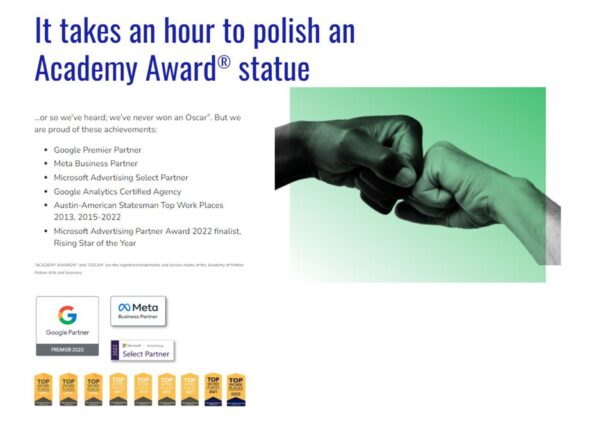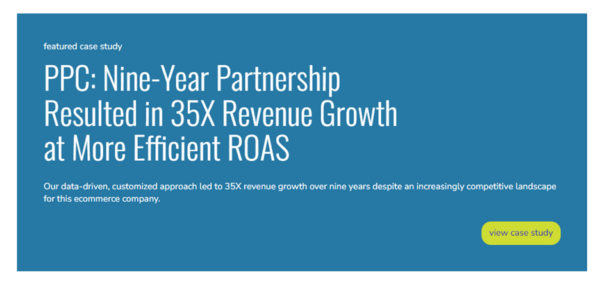Improving website performance through Conversion Rate Optimization (CRO) is essential for businesses looking to maximize their online presence and increase user actions on site. While most other areas of digital marketing are focused on driving traffic towards your website, CRO focuses on ensuring your website can properly funnel that traffic into qualified leads and customers.
At a high level, conversion rate optimization is focused on increasing the percentage of users who complete a desired action on site. We focus on identifying areas of friction and work through testing phases to reduce that friction in order to ensure traffic flows to desired areas of the site and users are more likely to complete desired actions. In this blog post, we’ll explore key strategies and conversion rate optimization best practices we follow to enhance your website’s conversion rates.
Ensure You Understand Your Audience
Before diving into CRO best practices, it’s essential to have a deep and thorough understanding of your website’s current audience. Who are they? Does their current behavior on site differ from what you would expect? What are their preferences, pain points, and needs? Creating detailed user personas can provide valuable insights to tailor your CRO strategies effectively. Knowing your audience is the foundation of a successful CRO engagement.
Set Clear Conversion Goals
Setting clear and specific conversion goals is the next strategic requirement before we can get into CRO best practices. Whether it’s increasing product sales, generating leads, or getting more subscribers, defining your goals will help you focus your efforts effectively. Make sure your goals are measurable, achievable, and aligned with your business objectives. You can use our Conversion Rate Optimization calculator as a starting point to determine where your CVR is currently at compared to where it could be through a CRO engagement.
Compelling Call-to-Actions (CTAs)
Now that your audience and goals are defined, it’s time to drill down into your website itself and talk about CRO best practices. One of the biggest mistakes we see businesses make on their website is having too many potential next steps through competing call-to-actions (CTAs). Defining what is the desired next step for users to take at any point on your site will help guide your CTAs specifically as well as your CRO efforts overall and help you track progress. You want to ensure the desired path forward is clear for users.
Your CTAs should be persuasive and visually stand out on your website. Use actionable language that encourages users to take the desired action. Experiment with different CTA variations and placements to determine what works best for your audience (examples: “Schedule A Call”, “Learn More”, “Request Your Free Demo”, etc.). See our homepage CTA to “schedule a call” below.

Quick User Experience (UX) Checks
A seamless user experience is essential for higher conversion rates. Ensure that your website is:
- Mobile-responsive: With the increasing use of mobile devices, your website must be responsive and mobile-friendly. Ensure that your site looks and functions seamlessly on various screen sizes and devices, providing a consistent user experience.
- Fast-loading: Website speed is crucial for both user experience and CRO. Slow-loading pages can lead to high bounce rates and abandoned shopping carts/forms. Use tools like Google PageSpeed Insights to identify areas for improvement and optimize your site for faster load times.
- Easy to navigate: A user-friendly and intuitive navigation menu is essential for CRO. Make it easy for visitors to find what they’re looking for with clear labels and a logical hierarchy. Minimize clutter and distractions on your website to keep the focus on conversion points.
- Clear and concise: Content should be well-structured, with compelling headlines and visuals to engage users.
Quality Content
High-quality, relevant content can significantly impact conversion rates. Regularly update your blog with valuable information that addresses your audience’s questions and concerns. Ensure product descriptions are informative and highlight benefits to the user.
Leverage Social Proof
Incorporate social proof elements such as customer reviews, testimonials, case studies, and trust badges on your website. These elements build trust and credibility with your audience, making them more likely to convert. See the certifications, awards, and case studies we feature on our homepage as social proof below.


Reduce User Friction Throughout Their Journey
Identify and eliminate any barriers or friction points that may hinder conversions. This could include simplifying the checkout process, offering multiple payment options, or providing easily accessible contact information for customer inquiries. An overall key to remember is that you want to eliminate distractions and keep the user’s attention on the desired path forward.
Monitor and Analyze
Regularly monitor your website’s performance using tools like Google Analytics, heatmaps such as Hot Jar, and user behavior analysis. Keep an eye on key metrics such as bounce rate, click-through rate, and conversion rate. Use this data to continually refine your CRO strategies.
Let’s Talk About A/B Testing
A/B testing (split testing) is a cornerstone of CRO. Testing on site will always come from a data first approach and further backed by UX/UI best practice standards. Using the data, we can formulate hypotheses to determine what areas are most critical to test to effect conversion rate. Is user behavior showing a high bounce rate on forms? Let’s experiment with different form layouts. Are users only selecting “Contact Us” when you really want them to be hitting “Request A Demo”? Let’s look at user flow, CTA changes, different ordering on the page. Our main goal with testing is to identify what resonates best with your audience, analyze the results, and make data-driven decisions to refine your website’s performance continually.
Does It Work?
Let’s look at a real-life example where conversion rate optimization worked. This SaaS client’s main objective was increasing demo requests via their homepage. They are a leader in changing their industry from hardware to software solutions so they needed to better educate their potential client base to drive quality leads.
The (un)Common Logic CRO team started with an analysis of the user journey to determine what the user pain points were on the homepage and then they formulated a plan for testing. The homepage redesigns that were tested had two main changes. The first was to include a clear message on the product so users understood what was being offered, what pain points it addressed, and how our client’s product was going to solve it for them. Second, it included product imagery, tangible evidence of what the product was and how it worked. Then our team tested the design options to identify which one led to the highest increase in conversions.
The homepage changes led to a +550% increase in conversion rate.
Conversion Rate Optimization (CRO) is a dynamic process that can significantly impact your website’s performance and, ultimately, your bottom line. By understanding your audience, setting clear goals, and implementing the strategies outlined above, you can enhance your website’s conversion rates, drive more engagement, and achieve your online business objectives. Remember that CRO is an ongoing effort, so stay agile and responsive to evolving user behaviors and market trends.
Want to know more? Read about how our CRO team achieved an 83% increase in conversions in less than 60 days and a 70% increase in orders for an e-commerce client.
Contact us to talk about your conversion challenges and our approach to conversion rate optimization!
Improving website performance through Conversion Rate Optimization (CRO) is essential for businesses looking to maximize their online presence and increase user actions on site. While most other areas of digital marketing are focused on driving traffic towards your website, CRO focuses on ensuring your website can properly funnel that traffic into qualified leads and customers.
At a high level, conversion rate optimization is focused on increasing the percentage of users who complete a desired action on site. We focus on identifying areas of friction and work through testing phases to reduce that friction in order to ensure traffic flows to desired areas of the site and users are more likely to complete desired actions. In this blog post, we'll explore key strategies and conversion rate optimization best practices we follow to enhance your website's conversion rates.
Ensure You Understand Your Audience
Before diving into CRO best practices, it’s essential to have a deep and thorough understanding of your website’s current audience. Who are they? Does their current behavior on site differ from what you would expect? What are their preferences, pain points, and needs? Creating detailed user personas can provide valuable insights to tailor your CRO strategies effectively. Knowing your audience is the foundation of a successful CRO engagement.
Set Clear Conversion Goals
Setting clear and specific conversion goals is the next strategic requirement before we can get into CRO best practices. Whether it's increasing product sales, generating leads, or getting more subscribers, defining your goals will help you focus your efforts effectively. Make sure your goals are measurable, achievable, and aligned with your business objectives. You can use our Conversion Rate Optimization calculator as a starting point to determine where your CVR is currently at compared to where it could be through a CRO engagement.
Compelling Call-to-Actions (CTAs)
Now that your audience and goals are defined, it’s time to drill down into your website itself and talk about CRO best practices. One of the biggest mistakes we see businesses make on their website is having too many potential next steps through competing call-to-actions (CTAs). Defining what is the desired next step for users to take at any point on your site will help guide your CTAs specifically as well as your CRO efforts overall and help you track progress. You want to ensure the desired path forward is clear for users.
Your CTAs should be persuasive and visually stand out on your website. Use actionable language that encourages users to take the desired action. Experiment with different CTA variations and placements to determine what works best for your audience (examples: “Schedule A Call”, “Learn More”, “Request Your Free Demo”, etc.). See our homepage CTA to "schedule a call" below.

Quick User Experience (UX) Checks
A seamless user experience is essential for higher conversion rates. Ensure that your website is:
- Mobile-responsive: With the increasing use of mobile devices, your website must be responsive and mobile-friendly. Ensure that your site looks and functions seamlessly on various screen sizes and devices, providing a consistent user experience.
- Fast-loading: Website speed is crucial for both user experience and CRO. Slow-loading pages can lead to high bounce rates and abandoned shopping carts/forms. Use tools like Google PageSpeed Insights to identify areas for improvement and optimize your site for faster load times.
- Easy to navigate: A user-friendly and intuitive navigation menu is essential for CRO. Make it easy for visitors to find what they're looking for with clear labels and a logical hierarchy. Minimize clutter and distractions on your website to keep the focus on conversion points.
- Clear and concise: Content should be well-structured, with compelling headlines and visuals to engage users.
Quality Content
High-quality, relevant content can significantly impact conversion rates. Regularly update your blog with valuable information that addresses your audience's questions and concerns. Ensure product descriptions are informative and highlight benefits to the user.
Leverage Social Proof
Incorporate social proof elements such as customer reviews, testimonials, case studies, and trust badges on your website. These elements build trust and credibility with your audience, making them more likely to convert. See the certifications, awards, and case studies we feature on our homepage as social proof below.


Reduce User Friction Throughout Their Journey
Identify and eliminate any barriers or friction points that may hinder conversions. This could include simplifying the checkout process, offering multiple payment options, or providing easily accessible contact information for customer inquiries. An overall key to remember is that you want to eliminate distractions and keep the user's attention on the desired path forward.
Monitor and Analyze
Regularly monitor your website's performance using tools like Google Analytics, heatmaps such as Hot Jar, and user behavior analysis. Keep an eye on key metrics such as bounce rate, click-through rate, and conversion rate. Use this data to continually refine your CRO strategies.
Let’s Talk About A/B Testing
A/B testing (split testing) is a cornerstone of CRO. Testing on site will always come from a data first approach and further backed by UX/UI best practice standards. Using the data, we can formulate hypotheses to determine what areas are most critical to test to effect conversion rate. Is user behavior showing a high bounce rate on forms? Let’s experiment with different form layouts. Are users only selecting “Contact Us” when you really want them to be hitting “Request A Demo”? Let’s look at user flow, CTA changes, different ordering on the page. Our main goal with testing is to identify what resonates best with your audience, analyze the results, and make data-driven decisions to refine your website's performance continually.
Does It Work?
Let’s look at a real-life example where conversion rate optimization worked. This SaaS client’s main objective was increasing demo requests via their homepage. They are a leader in changing their industry from hardware to software solutions so they needed to better educate their potential client base to drive quality leads.
The (un)Common Logic CRO team started with an analysis of the user journey to determine what the user pain points were on the homepage and then they formulated a plan for testing. The homepage redesigns that were tested had two main changes. The first was to include a clear message on the product so users understood what was being offered, what pain points it addressed, and how our client’s product was going to solve it for them. Second, it included product imagery, tangible evidence of what the product was and how it worked. Then our team tested the design options to identify which one led to the highest increase in conversions.
The homepage changes led to a +550% increase in conversion rate.
Conversion Rate Optimization (CRO) is a dynamic process that can significantly impact your website's performance and, ultimately, your bottom line. By understanding your audience, setting clear goals, and implementing the strategies outlined above, you can enhance your website's conversion rates, drive more engagement, and achieve your online business objectives. Remember that CRO is an ongoing effort, so stay agile and responsive to evolving user behaviors and market trends.
Want to know more? Read about how our CRO team achieved an 83% increase in conversions in less than 60 days and a 70% increase in orders for an e-commerce client.
Contact us to talk about your conversion challenges and our approach to conversion rate optimization!

